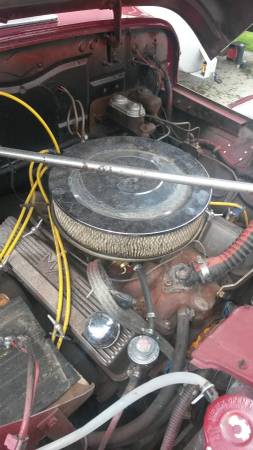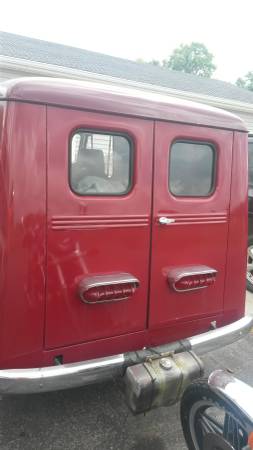UPDATE: **SOLD** Was $4500.
Still needs some work.
“Hi we have a 1948 willys panel van deluxe for sale was a father son project never had any time to work on it does need sum work inside it has a 67 elcomino motor which is a 287 bored out to a 307 has new tires pretty sweet paint job mostly complete has a 3 speed on the floor dual mufflers have brand new gas tank just isn’t installed yet have mostly all parts to put it in to much to list 4500obo call to set up apt to view thanks for looking”





Is that a fuel tank attached to the rear bumper? I’d call it the Pinto modification.
lol … no way! That must be a joke of some kind?
I can’t remember if I wrote this in my book, but I was in a 1972 pinto that was rear ended. When the rear bumper and panel is crushed, it caused the fuel inlet hose to disconnect from the gas tank. If the gas tank is full enough (2/3 or higher I think), gas will drain out of the tank. Some design genius put the exhaust pipe in the same location. This means the gas would drain out of the tank and onto the hot pipe. Fortunately for us, there was only a 1/4 tank.
The insurance company totaled the Pinto for $1100, but dad bought it back for $500. He fixed the house so that it couldn’t pop off. Then, he bought a second Pinto for another $500. He fixed that tank and that became my first car. They weren’t pretty, but those two Pintos ran forever with zero maintenance.
Is that for moonshine? Or smokescreen ALA Spyhunter?
Great Pinto story Dave, My dad also had a 1972 Pinto; took a licking and kept on ticking.
Years ago I worked as a helper in a body shop. When a fuel tank was damaged the owner would repair the tank by gas welding the cracks. His explanation was “Gasoline doesn’t burn, it has to mix with the atmosphere to burn” so all the fuel tanks were filled with gas before he began welding. The fuel outside of the tank would catch fire but so long as the tank was filled to the top of the filler neck there was never an explosion. I don’t miss that job.
Check out them tail lights and a 287 motor?
Paul, years ago, I had my fuel tank welded on my CJ5, often wondered how they did that. Thanks for the answer. Another one of life’s mysteries sloved.
DO NOT DO ANY OF THIS. NONE OF THIS IS ADVICE. Mike, it is unlikely your gas tank was repaired like that. The theory holds true as is Paul’s experience. But all I’ve heard is fill with water.
I worked for three companies that repaired their own diesel fuel tanks. All steam cleaned the interior of the tanks excessively. One tested with an explosimeter, the railroad does not, at least in my shop. Large vehicle diesel fuel tanks have internal baffles to eliminate some of the slosh of fuel, that is where the cracks typically occur.
The guy across the street is not your typical mechanical engineer, this guy can actually fix things too. I don’t know what the preparations he took were, but he restored an AMX and soldered the gas tank with one of those old, large copper soldering irons to eliminate any flame.
DO NOT TRY ANY OF THIS AT HOME. I POST ONLY FOR THE MATTER OF DISCUSSION!!!!!!!!!!
John
John,
If you hear you correctly, I shouldn’t try this at home? lol … love the disclaimer (can never be too careful!) . Just look at the kids lighting their bodies on fire (the fire challenge they call that). It’s all fun ’til someone gets burned.
– Dave
John, Thanks for the sound advice; I would never try this type of repair. Just as a sidebar, I remember another time I was leaking gas Big time from the tank on my 1960 Willys wagon. I used some chewing gum, Juicy Fruit as I remember, to stop the leak.
Maybe things are becoming more simple. Have them try to repair the fuel tank and post it on U-Tube.
John
I’m still here and I have a story. I worked on semi’s, 23 yo and this old truck driver there had like a Chevy Impala (1970???) with the tank fill behind the license plate. He had the tank taken out and repaired twice, then replaced, and it still leaked. He asked if I could look at it. Turns out it was the gas cap.
John